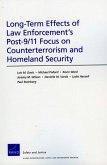- Broschiertes Buch
- Merkliste
- Auf die Merkliste
- Bewerten Bewerten
- Teilen
- Produkt teilen
- Produkterinnerung
- Produkterinnerung
For courses in Introduction to Security and Introduction to Private Security. A global perspective of security issues combined with broad practical coverage of crime prevention strategies. Private Security Today includes topical coverage that spans the evolution of security, through the present, to the future of the field.To give readers a look at the diverse issues contemporary security professionals face, this globally-focused overview incorporates international components from outside the U.S., as well as a multidisciplinary analysis of the field. Theories are presented in a way that asks…mehr
Andere Kunden interessierten sich auch für
![Morocco's War on Terrorism: The Case for Security Cooperation Today Morocco's War on Terrorism: The Case for Security Cooperation Today]() Mostafa El RezraziMorocco's War on Terrorism: The Case for Security Cooperation Today24,50 €
Mostafa El RezraziMorocco's War on Terrorism: The Case for Security Cooperation Today24,50 €![Zero Fail Zero Fail]() Carol LeonnigZero Fail18,99 €
Carol LeonnigZero Fail18,99 €![Long-Term Effects of Law Enforcement's Post-9/11 Focus on Counterterrorism and Homeland Security Long-Term Effects of Law Enforcement's Post-9/11 Focus on Counterterrorism and Homeland Security]() Lois M DavisLong-Term Effects of Law Enforcement's Post-9/11 Focus on Counterterrorism and Homeland Security23,99 €
Lois M DavisLong-Term Effects of Law Enforcement's Post-9/11 Focus on Counterterrorism and Homeland Security23,99 €![Keeping Law Enforcement Connected Keeping Law Enforcement Connected]() John GordonKeeping Law Enforcement Connected22,99 €
John GordonKeeping Law Enforcement Connected22,99 €![The Gendered and Colonial Lives of Gurkhas in Private Security The Gendered and Colonial Lives of Gurkhas in Private Security]() Amanda ChisholmThe Gendered and Colonial Lives of Gurkhas in Private Security35,99 €
Amanda ChisholmThe Gendered and Colonial Lives of Gurkhas in Private Security35,99 €![American Prison American Prison]() Shane BauerAmerican Prison17,99 €
Shane BauerAmerican Prison17,99 €![The Districts The Districts]() Johnny DwyerThe Districts15,99 €
Johnny DwyerThe Districts15,99 €-
-
-
For courses in Introduction to Security and Introduction to Private Security. A global perspective of security issues combined with broad practical coverage of crime prevention strategies. Private Security Today includes topical coverage that spans the evolution of security, through the present, to the future of the field.To give readers a look at the diverse issues contemporary security professionals face, this globally-focused overview incorporates international components from outside the U.S., as well as a multidisciplinary analysis of the field. Theories are presented in a way that asks readers to consider the balance of individual personal freedoms and public safety for society as a whole. The topics in the text were chosen based on student, professional, and professor recommendations to ensure that the coverage is both relevant and current. Throughout the book, engaging learning tools and real-world examples encourage students to think critically about the state of security today.
Hinweis: Dieser Artikel kann nur an eine deutsche Lieferadresse ausgeliefert werden.
Hinweis: Dieser Artikel kann nur an eine deutsche Lieferadresse ausgeliefert werden.
Produktdetails
- Produktdetails
- Verlag: Pearson Education
- Seitenzahl: 384
- Erscheinungstermin: 26. Februar 2016
- Englisch
- Abmessung: 274mm x 213mm x 18mm
- Gewicht: 748g
- ISBN-13: 9780133377156
- ISBN-10: 0133377156
- Artikelnr.: 44514873
- Herstellerkennzeichnung
- Libri GmbH
- Europaallee 1
- 36244 Bad Hersfeld
- gpsr@libri.de
- Verlag: Pearson Education
- Seitenzahl: 384
- Erscheinungstermin: 26. Februar 2016
- Englisch
- Abmessung: 274mm x 213mm x 18mm
- Gewicht: 748g
- ISBN-13: 9780133377156
- ISBN-10: 0133377156
- Artikelnr.: 44514873
- Herstellerkennzeichnung
- Libri GmbH
- Europaallee 1
- 36244 Bad Hersfeld
- gpsr@libri.de
Carter F. Smith teaches security and criminal justice courses in the Department of Criminal Justice Administration at Middle Tennessee State University in Murfreesboro, TN. He has also taught at Austin Peay State University and the Florida Institute of Technology. Dr. Smith received a Ph.D. in Business Administration from Northcentral University, a Juris Doctorate from Southern Illinois University, and a Bachelor of Science Degree from Austin Peay State University. He has taught Security and Security Administration courses since 2005. Smith has taught classes for many Gang Investigators Associations, the Academy of Criminal Justice Sciences, the National Crime Prevention Council, the Regional Organized Crime Information Center, the National Gang Crime Research Center, the Southern Criminal Justice Association, the U.S. Department of Justice and the U.S. Army. Smith is a retired U.S. Army Criminal Investigations Division (CID) Command Special Agent. He provided and directed the security of several U.S. Army bases, supervised multi-national fraud and theft investigations, and conducted various criminal and cyber-crime investigations in Germany, Korea, Panama, and the United States. He has been interviewed by several national, regional and local television, print, internet and radio news sources, and has appeared twice in the History Channel's Gangland series. He is a member of the Academy of Criminal Justice Sciences (ACJS), The American Society of Criminology, the Southern Criminal Justice Association, the American Criminal Justice Association, the Fraternal Order of Police, Infragard, and ASIS International. Frank Schmalleger, Ph.D., is Professor Emeritus at The University of North Carolina at Pembroke, where he also was recognized as Distinguished Professor. Dr. Schmalleger holds degrees from the University of Notre Dame and The Ohio State University; he earned both a master's and a doctorate in sociology, with a special emphasis in criminology, from The Ohio State University. From 1976 to 1994, he taught criminal justice courses at The University of North Carolina at Pembroke, and for the last 16 of those years, he chaired the university's Department of Sociology, Social Work, and Criminal Justice. As an adjunct professor with Webster University in St. Louis, Missouri, Schmalleger helped develop the university's graduate program in security administration and loss prevention and taught courses in that curriculum for more than a decade. Schmalleger has also taught in the New School for Social Research's online graduate program, helping build the world's first electronic classrooms in support of distance learning through computer telecommunications. Schmalleger is the author of numerous articles as well as many books: Criminal Justice Today: An Introductory Text for the 21st Century (Pearson, 2015), now in its thirteenth edition; Juvenile Delinquency (with Clemmens Bartollas; Pearson, 2014); Criminal Justice: A Brief Introduction, Tenth Edition (Pearson 2014); Criminal Law Today, Fifth Edition (Pearson, 2014); Corrections in the Twenty-First Century (with John Smykla; McGraw-Hill, 2015); and many other titles. He is also founding editor of the Journal of Criminal Justice Studies (formerly The Justice Professional). Larry J. Siegel, a graduate of Christopher Columbus High School in the Bronx, received his BA at the City College of New York, and his MA and Ph.D. in Criminal Justice at the State University of New York at Albany, Dr. Siegel began his teaching career at Northeastern University-where he was a faculty member for nine years and held teaching positions at the University of Nebraska-Omaha and Saint Anselm College in New Hampshire before joining the faculty of the Department of Criminal Justice and Criminology at the University of Massachusetts-Lowell where he taught for the past 26 years. He is now a professor emeritus and adjunct professor in the graduate program in the School of Criminology and Justice Studies. Dr. Siegel has also written extensively in the area of crime and justice, including books on juvenile law, delinquency, criminology, corrections, courts and criminal procedure. He is a court certified expert on police conduct and has testified in numerous legal cases.
Chapter 1 Origins and Foundations of Security 1
Introduction 2
The History of Security 3
Security in European History 3
Security in North America 4
Spotlight Allan Pinkerton 5
Security Today 7
Defining Security 10
The Need for Security 11
Security Professionals 12
Academic Recognition 13
Security Careers 13
The Role of Security 14
Private Security and Public Space 16
Private Security and Law Enforcement 17
Agency Cooperation 17
Overcoming Obstacles to Cooperation 18
The Effect of Homeland Security and Emergency Management 18
Volunteers in Security 19
Neighborhood Watch 19
Stand Your Ground 20
Spotlight Trayvon Martin and George Zimmerman 20
Challenges in the Security Field 20
Professional Organizations 22
Summary 24
Chapter 2 Theoretical Foundations of Security 26
Introduction 27
Why Do People Commit Crime? 28
Focus on the Individual 28
It's a Rational Choice 28
It's in Your Makeup 29
It's in Your Mind 29
It's a Lack of Self-Control 30
Social Influences 30
It's the Environment 30
It is How You Are Raised 31
Learning View 31
Control View 32
Multiple Causes/Multiple Crimes 32
The Crime Triangle 33
Controlling People 34
General Deterrence 34
Specific Deterrence 34
Controlling Places 34
Situational Crime Prevention 34
Security in Practice Communities Feel Safer with Private Security 35
Defensible Space 35
Crime Prevention through Environmental Design 36
Displacement and Diffusion 37
Diffusion 37
Broken Windows Theory 38
Game Theory 38
Summary 39
Key Terms 40
Review Questions 40
Practical Application 40
Chapter 3 Security Administration and Management 42
Introduction 43
The Business of Security 43
Security Programs: Proprietary versus Contractual 44
Spotlight What Security Executives Should Know about Ethics 45
Business Principles 45
Ethics 45
Explaining Ethics 46
Natural Law 46
Ethical Theory 46
Religious Principles 47
Legal Requirements 47
Ethical Practice 48
Ethical Systems 48
Introduction 2
The History of Security 3
Security in European History 3
Security in North America 4
Spotlight Allan Pinkerton 5
Security Today 7
Defining Security 10
The Need for Security 11
Security Professionals 12
Academic Recognition 13
Security Careers 13
The Role of Security 14
Private Security and Public Space 16
Private Security and Law Enforcement 17
Agency Cooperation 17
Overcoming Obstacles to Cooperation 18
The Effect of Homeland Security and Emergency Management 18
Volunteers in Security 19
Neighborhood Watch 19
Stand Your Ground 20
Spotlight Trayvon Martin and George Zimmerman 20
Challenges in the Security Field 20
Professional Organizations 22
Summary 24
Chapter 2 Theoretical Foundations of Security 26
Introduction 27
Why Do People Commit Crime? 28
Focus on the Individual 28
It's a Rational Choice 28
It's in Your Makeup 29
It's in Your Mind 29
It's a Lack of Self-Control 30
Social Influences 30
It's the Environment 30
It is How You Are Raised 31
Learning View 31
Control View 32
Multiple Causes/Multiple Crimes 32
The Crime Triangle 33
Controlling People 34
General Deterrence 34
Specific Deterrence 34
Controlling Places 34
Situational Crime Prevention 34
Security in Practice Communities Feel Safer with Private Security 35
Defensible Space 35
Crime Prevention through Environmental Design 36
Displacement and Diffusion 37
Diffusion 37
Broken Windows Theory 38
Game Theory 38
Summary 39
Key Terms 40
Review Questions 40
Practical Application 40
Chapter 3 Security Administration and Management 42
Introduction 43
The Business of Security 43
Security Programs: Proprietary versus Contractual 44
Spotlight What Security Executives Should Know about Ethics 45
Business Principles 45
Ethics 45
Explaining Ethics 46
Natural Law 46
Ethical Theory 46
Religious Principles 47
Legal Requirements 47
Ethical Practice 48
Ethical Systems 48
Chapter 1 Origins and Foundations of Security 1
Introduction 2
The History of Security 3
Security in European History 3
Security in North America 4
Spotlight Allan Pinkerton 5
Security Today 7
Defining Security 10
The Need for Security 11
Security Professionals 12
Academic Recognition 13
Security Careers 13
The Role of Security 14
Private Security and Public Space 16
Private Security and Law Enforcement 17
Agency Cooperation 17
Overcoming Obstacles to Cooperation 18
The Effect of Homeland Security and Emergency Management 18
Volunteers in Security 19
Neighborhood Watch 19
Stand Your Ground 20
Spotlight Trayvon Martin and George Zimmerman 20
Challenges in the Security Field 20
Professional Organizations 22
Summary 24
Chapter 2 Theoretical Foundations of Security 26
Introduction 27
Why Do People Commit Crime? 28
Focus on the Individual 28
It's a Rational Choice 28
It's in Your Makeup 29
It's in Your Mind 29
It's a Lack of Self-Control 30
Social Influences 30
It's the Environment 30
It is How You Are Raised 31
Learning View 31
Control View 32
Multiple Causes/Multiple Crimes 32
The Crime Triangle 33
Controlling People 34
General Deterrence 34
Specific Deterrence 34
Controlling Places 34
Situational Crime Prevention 34
Security in Practice Communities Feel Safer with Private Security 35
Defensible Space 35
Crime Prevention through Environmental Design 36
Displacement and Diffusion 37
Diffusion 37
Broken Windows Theory 38
Game Theory 38
Summary 39
Key Terms 40
Review Questions 40
Practical Application 40
Chapter 3 Security Administration and Management 42
Introduction 43
The Business of Security 43
Security Programs: Proprietary versus Contractual 44
Spotlight What Security Executives Should Know about Ethics 45
Business Principles 45
Ethics 45
Explaining Ethics 46
Natural Law 46
Ethical Theory 46
Religious Principles 47
Legal Requirements 47
Ethical Practice 48
Ethical Systems 48
Introduction 2
The History of Security 3
Security in European History 3
Security in North America 4
Spotlight Allan Pinkerton 5
Security Today 7
Defining Security 10
The Need for Security 11
Security Professionals 12
Academic Recognition 13
Security Careers 13
The Role of Security 14
Private Security and Public Space 16
Private Security and Law Enforcement 17
Agency Cooperation 17
Overcoming Obstacles to Cooperation 18
The Effect of Homeland Security and Emergency Management 18
Volunteers in Security 19
Neighborhood Watch 19
Stand Your Ground 20
Spotlight Trayvon Martin and George Zimmerman 20
Challenges in the Security Field 20
Professional Organizations 22
Summary 24
Chapter 2 Theoretical Foundations of Security 26
Introduction 27
Why Do People Commit Crime? 28
Focus on the Individual 28
It's a Rational Choice 28
It's in Your Makeup 29
It's in Your Mind 29
It's a Lack of Self-Control 30
Social Influences 30
It's the Environment 30
It is How You Are Raised 31
Learning View 31
Control View 32
Multiple Causes/Multiple Crimes 32
The Crime Triangle 33
Controlling People 34
General Deterrence 34
Specific Deterrence 34
Controlling Places 34
Situational Crime Prevention 34
Security in Practice Communities Feel Safer with Private Security 35
Defensible Space 35
Crime Prevention through Environmental Design 36
Displacement and Diffusion 37
Diffusion 37
Broken Windows Theory 38
Game Theory 38
Summary 39
Key Terms 40
Review Questions 40
Practical Application 40
Chapter 3 Security Administration and Management 42
Introduction 43
The Business of Security 43
Security Programs: Proprietary versus Contractual 44
Spotlight What Security Executives Should Know about Ethics 45
Business Principles 45
Ethics 45
Explaining Ethics 46
Natural Law 46
Ethical Theory 46
Religious Principles 47
Legal Requirements 47
Ethical Practice 48
Ethical Systems 48








